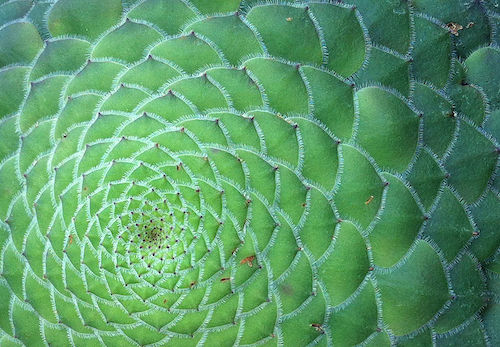 Evolution
Evolution
 Intelligent Design
Intelligent Design
Do We Live in a "Golden Ratio" Universe?

Writing recently about the Golden Ratio, we described how spiral shells grow according to that special ratio, designated by the Greek letter phi (? = 1.618…), based on the Fibonacci series, that the human eye finds pleasing. Since hurricanes and spiral galaxies also follow the same proportions, it seems that natural laws can explain how non-living spirals in hurricanes and galaxies will grow, but living things like ammonite shells require genetic instructions. This is evidence of intelligent design, because no natural law pulls silicon out of seawater and fashions it into exquisite spirals without being directed by a code. The ubiquity of ? in so many unrelated phenomena, both living and nonliving, suggests a deeper level of design in the universe.
Now two scientists from South Africa say that ? is the key to unifying all of science. A news item from the University of Witwatersrand (“Wits” for short) in Johannesburg summarizes an article of scientific correspondence by Jan Boeyens, a former Wits University Professor and now at the Centre for Advancement of Scholarship at the University of Pretoria, and Professor Francis Thackeray, a paleontologist at Wits University’s Evolutionary Studies Institute. Writing in the South African Journal of Science, “Number Theory and the Unity of Science,” Boeyens and Thackeray relate an astonishing list of apparently unrelated phenomena that follow the Golden Ratio:
- The curl of an elephant tusk
- The shape of a kudu’s horn
- Hurricane spirals
- The distribution of planets in the solar system
- A biological species constant, T
- The spiral structure of the cochlea ear-bone in a fossil hominin
- The logarithmic spirals of galaxies
- The structure of DNA
- The growth of many plants (phyllotaxis)
- The Periodic Table of the Elements
- Spiral shells of certain mollusks, like snails
- Spiral shells of living and extinct ammonites
- Stress patterns in nanomaterials
- The stability of atomic nuclides
- The topology of space-time
Boeyens even says that “concepts associated with relativity and quantum mechanics can be integrated, through the number 1.618.” He shows briefly how this is done.
To Boeyens and Thackeray, this evidence suggests a deep relationship in the fabric of space-time that includes biology:
We suggest that there is a strong case that this so-called ‘Golden Ratio’ (1.61803…) can be related not only to aspects of mathematics but also to physics, chemistry, biology and the topology of space-time….
Apart from the Golden Ratio, a second common factor among this variety of structures is that they all represent spontaneous growth patterns. The argument that this amazing consilience (‘self-similarity’) arises from a response to a common environmental constraint, which can only be an intrinsic feature of curved space-time, is compelling. (Emphasis added.)
In concluding, they argue for the unification of all the sciences around the Golden Ratio:
The time has come to recognise that relativity and quantum theories can be integrated, and linked numerically to the value of a mathematical constant — whether in the context of space-time or biology.
They never explain, though, why this should be so. Is it a requirement of any universe in a multiverse that it must follow the Golden Ratio? That idea would seem hard to defend; advocates of a multiverse typically agree that physical parameters could take on any values, because they wish to avoid the conclusion that our universe’s fine-tuned values were chosen by design. We live in a fine-tuned universe, they say, by luck: we won the Cosmic Lottery. A higher-level principle of natural selection dictates that complex life can only appear in a universe like ours.
Multiverse speculations might account for a finite set of lucky draws, but could it explain an all-pervasive ratio like ?? Could you have a universe with constants of gravity, electrical charges, and cosmological constant like ours, but with its space-time fabric following some other proportion? Why not? ? is an irrational number derived from a mathematical series, the Fibonacci series. There are plenty of other numerical series around. Why is a consistent mathematical form even necessary for a universe?
These are deep questions that can only be tested philosophically, because we only have one universe to observe. But it must strike any reasonable person as uncanny that so many phenomena are unified by a certain number, 1.618…, derived from a mathematical series, that permits the existence of “endless forms most beautiful.” The idea that nature can be unified in this manner is consistent with intelligent design in two ways: (1) Most contingent values of fundamental constants would preclude observers, and (2) the Golden Ratio gives the universe a beautiful form that aesthetically minded observers can appreciate.

